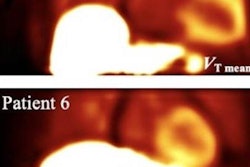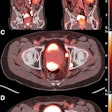
PET radiotracers that detect tau are more effective than those that target beta amyloid for predicting future cognitive decline in older patients with Alzheimer's disease, according to a study published August 12 in Alzheimer's Research and Therapy.
In a head-to-head study, German researchers compared PET radiotracers approved in the U.S. market for diagnosing Alzheimer's disease based on imaging tau protein and beta-amyloid plaque -- two pathological hallmarks of the disease. They found that tau PET performed best for predicting stages of development and cognitive decline in patients.
"Global tau‑PET is a better predictor of future cognitive decline than global amyloid‑PET," wrote Dr. Nicolai Franzmeier of Ludwig Maximilian University in Munich and colleagues of the international Alzheimer's Disease Neuroimaging Initiative (ADNI).
Current guidelines for determining whether a person has Alzheimer's disease and, if so, the severity of the condition, are based largely on PET imaging of accumulated amounts of beta-amyloid plaque and neurofibrillary tau protein tangles in the brain.
There are three radiotracers labeled with F-18 approved by the U.S. Food and Drug Administration (FDA) for clinical PET imaging of beta amyloid: Florbetapir (Amyvid, Avid Radiopharmaceuticals), florbetaben (Neuraceq, Life Molecular Imaging), and flutemetamol (Vizamyl, GE Healthcare). Flortaucipir (Tauvid, Avid Radiopharmaceuticals) received FDA clearance for imaging tau pathology last year.
Despite these developments, a reliable prognosis of cognitive decline in Alzheimer's disease in clinical settings remains a critical yet unmet challenge, the authors wrote.
In this longitudinal study, the researchers evaluated images of 239 patients from the ADNI database who underwent PET scans at baseline with amyloid PET or tau PET radiotracers. Patients were categorized by ADNI guidelines as cognitively normal (CN), mildly cognitively impaired (MCI), or demented.
After two years, 14 of the cognitively normal group converted to MCI (i.e., a 5.86% conversion rate), with no conversions to dementia observed. In the MCI group, 14 patients converted to dementia.
Higher baseline global tau PET and amyloid PET standardized uptake value ratios (SUVRs) were both associated with faster cognitive decline, yet baseline global tau PET SUVRs explained more variance in future cognitive decline than amyloid PET across all cognitive tests and diagnostic groups, the authors found.
Associations between tau PET and cognitive decline remained consistent when controlling for amyloid PET, while associations between amyloid PET and cognitive decline were nonsignificant when controlling for tau PET.
The researchers compared the predictive accuracy of baseline tau status and amyloid status for future conversion risk from cognitively normal to MCI/dementia and from MCI to dementia during follow-up and found scores were higher for tau status compared with beta-amyloid status.
Specifically, beta amyloid-positive individuals had a conversion risk of 13.07% (n = 20/153) versus 3.85% (n = 8/208) in beta amyloid-negative individuals, while tau-positive patients had a 21.8% (n = 17/78) conversion risk versus 3.89% (n = 11/283) in tau-negative individuals.
"This finding supports tau PET as a much better predictor for cognitive decline than amyloid PET when it comes to prognostication of future cognitive decline," the authors wrote.
The authors noted studies have shown that tau pathology emerges much closer to symptom onset than beta amyloid in Alzheimer's disease and that their findings are congruent with the amyloid cascade hypothesis. The cascade hypothesis suggests that beta amyloid is the initial trigger of pathological tau in Alzheimer's disease and precedes symptom onset by decades, while tau is the actual driver of neurodegeneration and cognitive decline.
Ultimately, focusing on beta-amyloid biomarkers is key for Alzheimer's disease diagnosis, but it is likely insufficient for reliable prediction of clinical disease trajectories, the authors stated.
"We show that tau PET outperforms amyloid PET in predicting cognitive decline and clinical [Alzheimer's disease] progression, supporting the notion that tau PET is -- in contrast to amyloid PET -- of high clinical usefulness as a single meaningful predictor of future cognitive decline and clinical [Alzheimer's disease] progression," the authors concluded.





















